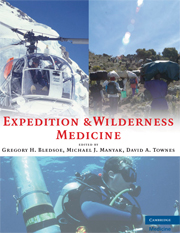Book contents
- Frontmatter
- Contents
- Contributors
- Foreword
- Preface
- Acknowledgments
- PART I EXPEDITION PLANNING
- PART II EXPEDITIONS IN UNIQUE ENVIRONMENTS
- PART III ILLNESS AND INJURIES ON EXPEDITIONS
- 24 General Medical
- 25 The Diarrhea of Travelers
- 26 Malaria: Diagnosis, Prevention, and Treatment for the Traveler
- 27 Wild Animal Attacks and Injuries
- 28 Snake and Arthropod Envenoming
- 29 Hazardous Marine Life
- 30 Expedition Toxicology
- 31 Environmental Injuries
- 32 Penetrating and Explosive Wounds
- 33 Drowning and Submersion Injury
- 34 Evaluation and Acute Resuscitation of the Trauma Patient
- 35 Principles and Practice of Expedition Wound Management
- 36 Expedition Eye Injuries and Disorders
- 37 Dental Medicine on Expedition
- 38 Foot Injuries
- 39 Expedition Orthopedics
- 40 Expedition Self-Rescue and Evacuation
- 41 Aeromedical Evacuations
- APPENDIX The Expedition Medical Kit
- Index
39 - Expedition Orthopedics
from PART III - ILLNESS AND INJURIES ON EXPEDITIONS
Published online by Cambridge University Press: 05 March 2013
- Frontmatter
- Contents
- Contributors
- Foreword
- Preface
- Acknowledgments
- PART I EXPEDITION PLANNING
- PART II EXPEDITIONS IN UNIQUE ENVIRONMENTS
- PART III ILLNESS AND INJURIES ON EXPEDITIONS
- 24 General Medical
- 25 The Diarrhea of Travelers
- 26 Malaria: Diagnosis, Prevention, and Treatment for the Traveler
- 27 Wild Animal Attacks and Injuries
- 28 Snake and Arthropod Envenoming
- 29 Hazardous Marine Life
- 30 Expedition Toxicology
- 31 Environmental Injuries
- 32 Penetrating and Explosive Wounds
- 33 Drowning and Submersion Injury
- 34 Evaluation and Acute Resuscitation of the Trauma Patient
- 35 Principles and Practice of Expedition Wound Management
- 36 Expedition Eye Injuries and Disorders
- 37 Dental Medicine on Expedition
- 38 Foot Injuries
- 39 Expedition Orthopedics
- 40 Expedition Self-Rescue and Evacuation
- 41 Aeromedical Evacuations
- APPENDIX The Expedition Medical Kit
- Index
Summary
INTRODUCTION – INITIAL APPROACH TO TRAUMA IN THE FIELD
Traumatic events in the wilderness are dramatic. It is easy to become emotional. The victim may be a friend. The scene is often witnessed. A calm, rational approach is essential for proper assessment, stabilization, and treatment of the victim – saving lives and salvaging limbs. This chapter will focus on orthopedic diagnostic and stabilization techniques without the aid of radiography and without the burden of documentation.
INITIAL EVALUATION
In cases of wilderness trauma, always ensure the scene is safe before proceeding toward the victim. Never assume that the scene of any injury is safe. Do not magnify the problem by becoming a statistic yourself. An unstable debris field in an avalanche zone or a hidden crevasse field on a warm, sunny day may also prove hazardous to potential rescuers.
As you arrive at the victim's side, begin with the ABCs (airway, breathing, circulation). This is often difficult because the victim's orthopedic injuries may be very dramatic, and human nature draws our focus to them. Begin by assessing his or her airway and breathing. Call out to the patient to see if they can talk with you. Under most circumstances, hearing the victim speak with a normal voice suggests that the airway and breathing are adequate for the moment. If the victim does not respond to you, assess the airway and breathing by using the look, listen, and feel approach. Look for the symmetric, smooth rise and fall of the chest associated with normal breathing.
- Type
- Chapter
- Information
- Expedition and Wilderness Medicine , pp. 647 - 672Publisher: Cambridge University PressPrint publication year: 2008

